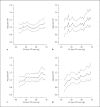Risk Associated with Pulse Pressure on Out-of-Office Blood Pressure Measurement
- PMID: 26587443
- PMCID: PMC4646147
- DOI: 10.1159/000369192
Risk Associated with Pulse Pressure on Out-of-Office Blood Pressure Measurement
Abstract
Background: Longitudinal studies have demonstrated that the risk of cardiovascular disease increases with pulse pressure (PP). However, PP remains an elusive cardiovascular risk factor with findings being inconsistent between studies. The 2013 ESH/ESC guideline proposed that PP is useful in stratification and suggested a threshold of 60 mm Hg, which is 10 mm Hg higher compared to that in the 2007 guideline; however, no justification for this increase was provided.
Methodology: Published thresholds of PP are based on office blood pressure measurement and often on arbitrary categorical analyses. In the International Database on Ambulatory blood pressure in relation to Cardiovascular Outcomes (IDACO) and the International Database on HOme blood pressure in relation to Cardiovascular Outcome (IDHOCO), we determined outcome-driven thresholds for PP based on ambulatory or home blood pressure measurement, respectively.
Results: The main findings were that for people aged <60 years, PP did not refine risk stratification, whereas in older people the thresholds were 64 and 76 mm Hg for the ambulatory and home PP, respectively. However, PP provided little added predictive value over and beyond classical risk factors.
Keywords: Blood pressure measurement; Cardiovascular diseases; Epidemiology; Pulse pressure; Thresholds.
Figures


References
-
- Staessen J, Amery A, Fagard R. Editorial review. Isolated systolic hypertension. J Hypertens. 1990;8:393–405. - PubMed
-
- Bangalore S, Messerli FH, Franklin SS, Mancia G, Champion A, Pepine CJ. Pulse pressure and risk of cardiovascular outcomes in patients with hypertension and coronary artery disease: an INternational VErapamil SR-trandolapril STudy (INVEST) analysis. Eur Heart J. 2009;30:1395–1401. - PubMed
-
- Madhavan S, Ooi WL, Cohen H, Alderman MH. Relation of pulse pressure and blood pressure reduction to the incidence of myocardial infarction. Hypertension. 1994;23:395–401. - PubMed
-
- Greenberg J. Antihypertensive treatment alters the predictive strength of pulse pressure and other blood pressure measures. Am J Hypertens. 2005;18:1033–1039. - PubMed
-
- Domanski MJ, Davis BR, Pfeffer MA, Kastantin M, Mitchell GF. Isolated systolic hypertension: prognostic information provided by pulse pressure. Hypertension. 1999;34:375–380. - PubMed
Publication types
Grants and funding
LinkOut - more resources
Full Text Sources
Other Literature Sources
Miscellaneous

